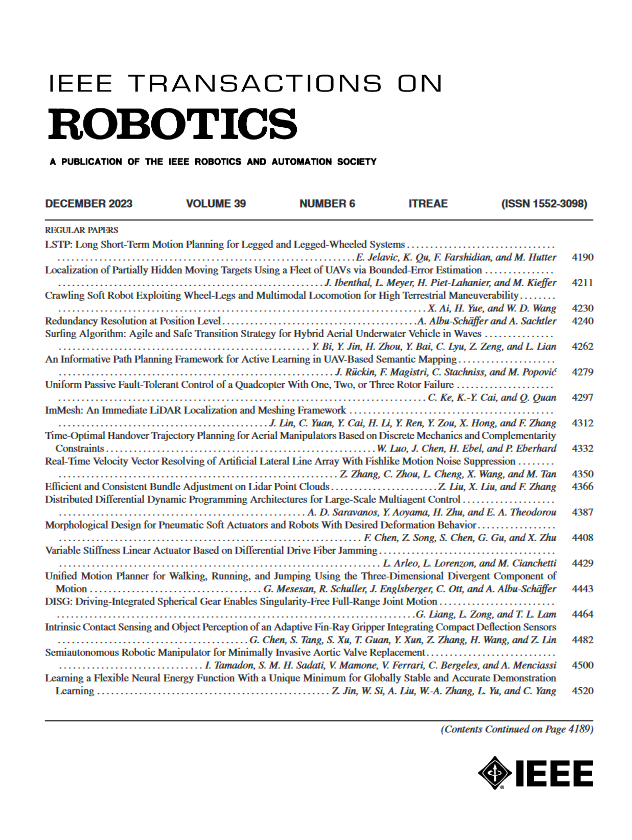不可抓握机器人重排操作的以物体为中心的运动学规划
IF 10.5
1区 计算机科学
Q1 ROBOTICS
引用次数: 0
摘要
不可掌握的动作,如推,对于解决多目标重排问题至关重要。许多传统的方法产生以机器人为中心的行动,这与人类的直觉策略不同,通常效率低下。为此,我们采用了一个以对象为中心的规划范式,并提出了一个统一的框架来解决一系列大规模的、物理密集型的、不可理解的重排问题,这些问题受到建模不准确性和现实世界不确定性的挑战。通过假设每个物体都可以主动移动而不受机器人交互的驱动,我们的规划器首先计算期望的物体运动,然后通过闭环推动策略在线生成机器人动作来实现。通过广泛的实验,并与仿真和物理机器人的最先进基线进行比较,我们表明,我们的以对象为中心的规划框架可以产生更直观和任务有效的机器人动作,并显着提高效率。此外,我们还提出了一种基准协议,以规范和促进未来不可卷曲重排的研究。本文章由计算机程序翻译,如有差异,请以英文原文为准。
Object-Centric Kinodynamic Planning for Nonprehensile Robot Rearrangement Manipulation
Nonprehensile actions, such as pushing, are crucial for addressing multiobject rearrangement problems. Many traditional methods generate robot-centric actions, which differ from intuitive human strategies and are typically inefficient. To this end, we adopt an object-centric planning paradigm and propose a unified framework for addressing a range of large-scale, physics-intensive nonprehensile rearrangement problems challenged by modeling inaccuracies and real-world uncertainties. By assuming that each object can actively move without being driven by robot interactions, our planner first computes desired object motions, which are then realized through robot actions generated online via a closed-loop pushing strategy. Through extensive experiments and in comparison with state-of-the-art baselines in both simulation and on a physical robot, we show that our object-centric planning framework can generate more intuitive and task-effective robot actions with significantly improved efficiency. In addition, we propose a benchmarking protocol to standardize and facilitate future research in nonprehensile rearrangement.
求助全文
通过发布文献求助,成功后即可免费获取论文全文。
去求助
来源期刊

IEEE Transactions on Robotics
工程技术-机器人学
CiteScore
14.90
自引率
5.10%
发文量
259
审稿时长
6.0 months
期刊介绍:
The IEEE Transactions on Robotics (T-RO) is dedicated to publishing fundamental papers covering all facets of robotics, drawing on interdisciplinary approaches from computer science, control systems, electrical engineering, mathematics, mechanical engineering, and beyond. From industrial applications to service and personal assistants, surgical operations to space, underwater, and remote exploration, robots and intelligent machines play pivotal roles across various domains, including entertainment, safety, search and rescue, military applications, agriculture, and intelligent vehicles.
Special emphasis is placed on intelligent machines and systems designed for unstructured environments, where a significant portion of the environment remains unknown and beyond direct sensing or control.
 求助内容:
求助内容: 应助结果提醒方式:
应助结果提醒方式:


